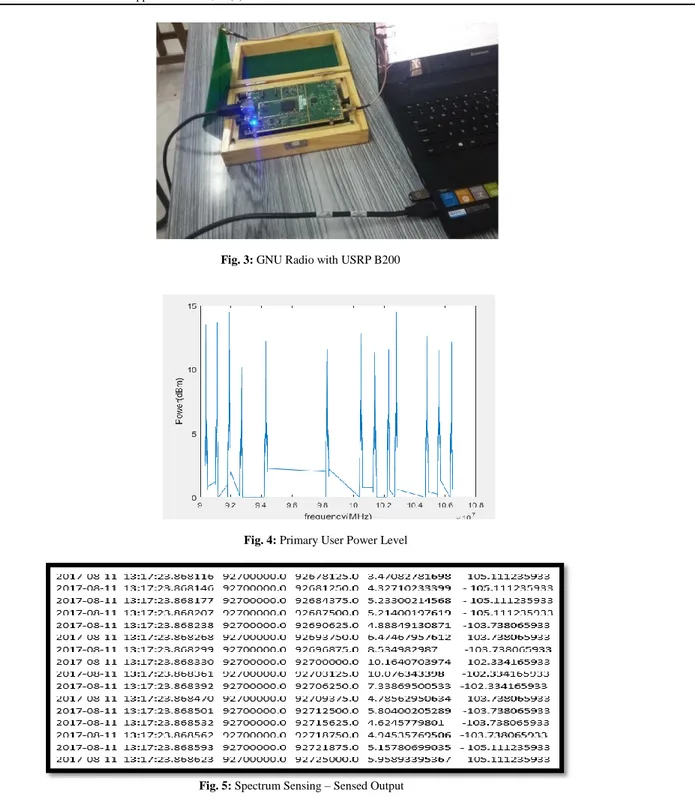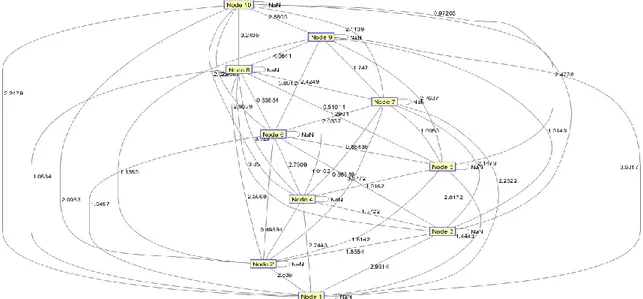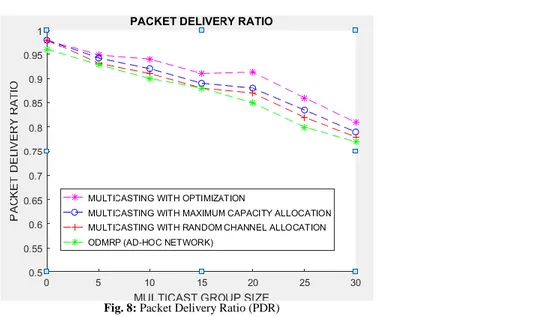Australian Journal of Basic and Applied Sciences
2018 January; 12(1): pages 15-21 DOI: 10.22587/ajbas.2018.12.1.4 Research Article AENSI Publications
Australian Journal of Basic and Applied Sciences ISSN: 1991-8178,EISSN: 2309-8414
Opportunistic Cognitive Multicast Routing
for Ad hoc Networks
1
Lavanya Shanmugavel,
2Madhumitha Jayaram,
3Bhagyaveni Marcharla Anjaneyulu
1Research Scholar, Department of Electronics and Communication Engineering, College of Engineering, Guindy, Anna University, Chennai-25, Tamil Nadu,
India.
2PG Student, Department of Electronics and Communication Engineering, College of Engineering, Guindy, Anna University, Chennai-25, Tamil Nadu, India. 3Professor, Department of Electronics and Communication Engineering, College of Engineering, Guindy, Anna University, Chennai-25, Tamil Nadu, India.
Correspondence Author: Madhumitha Jayaram, PG Scholar, Department of Electronics and Communication Engineering, College of Engineering, Guindy, Anna University, Chennai-25, Tamil Nadu, India
E-mail: madhumithajayaram29@gmail.com
Received date: 22 December 2017, Accepted date: 22 January 2018, Online date: 5 February 2018
Copyright: © 2018 Lavanya Shanmugavel et al. This is an open-access article distributed under the terms of the Creative Commons Attribution License, which permits unrestricted use, distribution, and reproduction in any medium, provided the original author and source are credited.
Key words:Multicast RoutingCognitive Radio Networks, Cross-Layer Optimization
INTRODUCTION
The radio frequency resources used in Wireless Networks are regulated by fixed Spectrum Assignment policy by FCC. Licenses are granted for the use of limited frequency bands on a long-term basis over large geographical areas. Alongside licensed frequency bands, unlicensed band usage (ISM band. etc.,) is increasing tremendously. Thus, the usage of licensed spectrum is uneven and less utilized (15% - 85%) while the unlicensed spectrum is overcrowded (Mitola et al., 1999). To address the Spectrum underutilization, Dynamic Spectrum Access has been proposed, (Goutam Ghosh et al., 2014) where the secondary users opportunistically utilize the licensed band for transmission. From the technical perspective, the advancements in Software Defined Radio enable operations on wide spectrum range with Spectrum Agility (J.Mitola. et al., 1999).To sense the spectrum available over the particular geographic area, centralized spectrum sensing has been performed using Software Defined Radio. GNU is a free and open source software that provides a graphical design framework for signal processing functions (K.H. Yusof et al). Real-time spectrum sensing can be performed during Cognitive transmission for Dynamic Spectrum Access (B. Siva Kumar Reddy et al., 2014).
Most of the Research in the field of Cognitive Radio Networks focuses on physical and MAC layers with a single hop and relay node issues by tackling spectrum sensing, spectrum allocation even in agile conditions(Alexander M. Wyglinski et al). CLORP (cross-layer opportunistic routing protocol), a reactive routing protocol for unicast data transmission, where opportunistic data transmission at each hop is through the best link having minimum EVM values has been discussed (Lavanya et al., 2016). The potentiality of multi-hop transmission is now unleashed and routing performances are being improved with various algorithms and optimization techniques for wireless Cognitive Networks (Samar Abdelaziza et al., 2012; et al; Kartikay Garg et al., 2014).
To perform multicasting in multi-hop wireless networks, the source needs to transmit data to more than one destination (Junaid Qadir. N et al). Due to heterogeneity among channels present at different SUs, conventional multicasting routing protocol couldn't be applied for multi-hop CRN (Hisham M. Almasaeid et al., 2010). However, single layer approach for multicasting selects a common channel from source to destination without in need for optimization of network-wide resources. To overcome this limitation in CRN, SUs uses information at the lower layers to ensure multicast connectivity for overall QOS enhancement (Mohsen Jahanshahi et al). So, to efficiently exploit multicasting in CRN, OCMRP has been implemented, where joint channel allocation and routing is performed (Zhihui Shu et al. 2013; Mohsen Jahanshahi et al., 2017).
In this paper, the performance of multicast multi-hop Cognitive Radio Network is evaluated. The main contributions include real-time spectrum sensing to identify white spaces for cognitive (SU) users. In addition to that, our proposed weight function enables Least Cost multi-hop Multicast routing. The rest of the paper is organized as follows. The work further describes the System Overview, the Implementation of Multicast Routing in Cognitive Radio Networks., Performance analysis of the proposed work and finally, the conclusion and future work.
Abstract
SYSTEM OVERVIEW
We consider fixed non-Cognitive (PU) FM network and SU ad-hoc network as shown in Figure 1. The PU network consists of a base station with 'M' PUs denoted as {PU1, PU2...PUM}. The assumption here is that each SU has a single radio but due to heterogeneity among channels, SU identify different sets of
channels. Figure 1 depicts the system model for the proposed protocol.
Fig. 1: System Model
Fig. 2: Proposed work- OCMRP
PROTOCOL OVERVIEW
The proposed protocol OCMRP includes 3 stages namely Real-time Spectrum Sensing using GNU Radio, Capacity based Channel Allocation and Least Cost Routing. The OCMRP involves the following steps as shown in Figure 2.
STEP 1: Real-Time Spectrum Sensing using GNU Radio is performed.
STEP 2: Based on Energy Detection technique, the unoccupied frequency spectrum, the white spaces have been identified.
STEP 3: The two Channel Allocation Algorithms, namely, Random Channel Allocation and Maximum Capacity Channel allocation are proposed and the Channels are allocated to the Secondary Users.
STEP 4: A weight function based on the Physical layer parameters is designed.
STEP 5: A Minimum Spanning Tree, a single route connecting all the nodes in the Network has been constructed based on the weights. STEP 6: Source and Multicast members are identified and Multicast Routing is performed.
REAL TIME SPECTRUM SENSING
The Hardware module of GNU Radio is shown in Figure 3. The hardware is interfaced for the measurement is USRP B200 from Ettus Research and a Laptop. It is a single board Universal Software Radio Peripheral (USRP) for spectrum coverage from 70MHZ - 6GHz. Here, Log periodic antenna is used for the reception of PU Signals. In our paper, Real-time Spectrum Sensing is performed over the Real Time Frequency Modulation Radio Station signal which operates between 88MHz and 108MHz. The 64 point FFT is chosen with 200 KHz Bandwidth with a resolution of 3.125 KHz.
The task of Spectrum Sensing includes detection of spectrum holes, spectrum resolution of each spectrum hole. The spectrum sensing technique used is Energy Detection. The energy detection is a simple spectrum sensing technique because of its low computational complexity and does not require any a priori knowledge. The Energy Detection schematic representation is as shown in Figure 3.The Spectrum Sensing is performed using GNU Radio with USRP B200 over the FM spectrum and the active primary user bands are sensed. The observed spectrum sensing power levels of the Primary Users are shown in Figure 4.The spectrum sensed results are presented in Figure 5. It provides the date and time of sensing, the center frequency of the entire Primary user bandwidth, the particular frequency, the power level and noise level. Here, the presence of Primary User signal is detected by comparing the energy detector output with a threshold
E.Table 1: USRP Parameters
S.No Parameters Characteristics
1 Hardware USRP B200 with UHD
2 FFT size 64
3 Resolution 3.125KHz
4 Bandwidth 200KHz
5 Center Frequency of PUs
(Radio Stations)
Active FM Radio Stations
(90.4, 91.1, 91.9, 92.7, 93.5, 94.3, 98.3, 100.5, 101.4, 102.3, 102.8, 104.8, 105.6, 106.4)MHZ
The unoccupied licensed spectrum is categorized as Channel Availability Matrix (CAM). Over the proposed scenario, 13 FM Primary Users have been sensed with 64 bins each. Thus, there are 832 frequencies are sensed using this centralized approach. If P is the power of the primary user, then
Fig. 3: GNU Radio with USRP B200
Fig. 4: Primary User Power Level
Fig. 5: Spectrum Sensing – Sensed Output
CAPACITY BASED CHANNEL ALLOCATION After preparing the CAM, the available channels are allocated to the SU.
Consider a network of Secondary Users G= {V,
}, where ‘V’ is the Vertices and ‘
’ is the edges of the Network. In Cognitive Radio scenario, the
= kE, where k is the number of free channels available between a pair of vertices and E is an edge. The Link Matrix S(i,j) is given byS(i,j)= 1if a link exists between the nodes i and j = 0Otherwise
The nodes are assumed to be in the transmission range of each other as shown in Figure 8. Based on the existence of primary user, a CAM has been computed as given Sec 3.1. A CAM has been defined which has a random number of channels allocated between the links (i,j) where the number of channels ranges between one and four as shown. From the CAM, random channel allocation is defined for each and every link between the nodes.
The capacity of the channel to be allocated across each link is calculated by (1)
2 0
log
( )
( )
(1
)
,
( )
b kE k
C
i j
k
B
N
k
(1)( )
,
C
i j
k
– Capacity of the channel (k)k
B
–Bandwidth of the channel Eb (k)- Energy per bitN0(k) - Noise of the channel (i) from the channel availability matrix
In this work, the number of Secondary nodes considered is N = 10.The number of channels available is given by avai[]. avai=
[0222314211 2011113141 2101434411 2110222431 3142041141 1132402112 4342120144 2144111042 1413414402 1111124220]
In this research, two Channel Allocation Algorithms have been proposed, namely,
1. Random Channel Allocation (RCA)
2. Maximum Capacity Channel Allocation (MCCA)
Random Channel Allocation (RCA)
From the free channels obtained after Spectrum Sensing, we have obtained 735 channels each of Bandwidth 3.125 KHz. All the 735 available channels are included in the Channel Availability Matrix (CAM).
In Random Channel Allocation (RCA), Number of channelsi,j = randperm(1,4) in avai[]
where i and j are the vertices of an edge For k=1-Number of channels available {
Channel N0i,j[k] = rand[1,735]
}
For k = 1 to number_of_channels {
channeli,j= arg{ Cap[] }
New_Cap[] = arg cap[] – channeli,j[k]
}
Based on the number of channels across the link, the corresponding number of channels are chosen randomly from the channel availability matrix and one channel is randomly allocated.
Maximum Capacity Channel Allocation (MCCA)
In Maximum Capacity Channel Allocation (MCCA), Number of channels,j = randperm(1,4)
where i and j are the vertices of an edge For k=1-Number of channels available {
Channel N0i,j[k] = rand[1,735]
}
For k = 1 to number_of_channels {
channeli,j= arg{ max(Cap[]) }
New_Cap[] = arg cap[] – channeli,j[k]
}
Thus, using Maximum Capacity Channel Allocation (MCCA), each link has been allocated the best channel, based on their Capacity. Further, the allocated channel is removed from the Channel Availability matrix and the matrix is updated.
The capacity of the channels is computed based on equation 1.This ensures quality links across the entire path and the link selects the channel with the maximum capacity and is calculated by (2)
( , )
max(
i)
C i j
C
(2)LEAST COST ROUTING
The channel allocation is followed by the weight computation function across each link. Each link has been assigned a weight which is a function of essential physical layer parameters of the network.
The weight function is given by (3)
,
*
*
,
*
( , )
k
k k k
dist i j
error
Pt
Weight i j
B
C i j
(3)Where,
Weight(i,j) – weight of the link between node i and node j dist(i,j) = distance between nodes i and j
Bk =Transmission Bandwidth of each User
Ck(i,j)= Capacity of the link (i,j) of the kth channel
Pt = Transmission Power of the node.
errork= noise(k) / max(noise(k)) +1 of the kth channel
The channels have been assigned to a Secondary User Network with the N=10 and their weights are computed as shown in Figure 6.Using the computed weights, a Minimum Spanning Tree (Least Cost Routing) has been constructed for the network as shown in Fig 7. In minimum spanning tree, a route, connecting all the nodes from source and all the multicast members in the receiver set is constructed. The weight function characterizing the physical layer parameters is used for least cost routing in the Network layer. Thus, ‘Cross-layer Optimization' is achieved.
Fig. 7: Multicast Routing using Minimum Spanning Tree (MST)
SIMULATION RESULTS
The simulation tools used are GNU Radio and MATLAB. After the computation of the Least Cost Route from source to all the destinations (the receiver set), the data packets are transmitted. The data is modulated using QPSK modulation scheme. The number of data packets considered is 1000. The number of destinations in the receiver set is three. At the receiver end, each destination receives the data packet from the source via the route computed using Minimum spanning tree. The Packet Delivery Ratio, the Packet Transmission Delay and the Spectrum Utilization Factor have been analysed.
Packet Delivery Ratio
On reception, the Packet Delivery Ratio (PDR) is computed at the destination. The Packet Delivery Ratio (PDR) is given by
Number of successful transmissions
PDR
Total number of transmissions
Fig. 8: Packet Delivery Ratio (PDR)
Packet Transmission Delay
The second parameter to be evaluated is Packet Transmission delay. In parallel, multiple unicasting is performed for the data transmission from the source to all the destinations individually. Transmission Delay is observed for both the cases. We observed that with an increase in the number of destinations, the transmission delay significantly increase in case of multiple unicasting. The Packet Transmission Delay performance has been presented in Figure 9 and it shows that Multicasting has better than multiple unicasting in transmission delay. In this particular case, for a multicast group size of four, Multicasting with MCCA, the transmission delay is 60% less compared to M-Unicasting.
Fig. 9: Packet Transmission Delay
Fig. 10: Spectrum Utilization Factor (SUF)
Spectrum Utilization Factor
The third parameter to be evaluated is the Spectrum Utilization Factor. It is defined as the ratio of the number of Allocated frequency Spectrum bands to the Total Available Spectrum bands. It is given by
21
Citation: Lavanya Shanmugavel, Madhumitha Jayaram, Bhagyaveni Marcharla Anjaneyulu, 2018. Opportunistic Cognitive Multicast Routing For Ad hoc
Networks. Australian Journal of Basic and Applied Sciences, 12(1): 15-21.
The Spectrum Availability Factor is observed for M-Unicasting, Multicasting with Random Channel Allocation and Multicasting with Maximum Capacity Channel Allocation. The Spectrum Utilization Factor for M-Unicasting is observed to be 10% less, compared to the Cognitive Multicasting with Random Channel Allocation and Multicasting with Maximum Capacity Channel Allocation is given in Figure 10. The Multicast Routing performs better by 10% compared to M-Unicasting.
CONCLUSION
In this paper, Cross-Layer Optimization is realized in the proposed OCMRP. Real-time spectrum sensing is performed using GNU Radio, the best ‘quality' channel is allocated to each link and Least Cost Routing is performed to obtain the best route from source to all the multicast members. Performance parameters namely, Packet Transmission Delay, Packet Delivery Ratio and Spectrum Utilization Factor has been analysed. In MCCA, the Packet transmission delay is improved by 60% and the Packet Delivery Ratio is 9% better than conventional Multicasting techniques. Thus, it is observed that the multi-hop OCMRP-MCCA shows better performance over Multiple Unicasting. In future, to enhance the throughput of the Cognitive Radio Network, OCMRP can be extended to multichannel allocation for every link in the network. In view of this, Power Optimization strategies can be formulated to reduce the transmit power of the Secondary user nodes.
REFERENCES
A Book: Alexander M. Wyglinski, Maziar Nekovee, and Y. Thomas Hou, Cognitive Radio Communications and Networks.
Goutam Ghosh, Prasun Das and Subhajit Chatterjee, 2014. Cognitive Radio and Dynamic Spectrum Access – A Study, International Journal of Next-Generation Networks (IJNGN) 6: 1.
Hannes Frey, François Ingelrest and David Simplot-Ryl, 2007 Localized Minimum Spanning Tree Based Multicast Routing with Energy-Efficient Guaranteed Delivery in Ad Hoc and Sensor Networks, French Institute for Research in Computer Science and Automation.
Hisham M. Almasaeid, Tasneem H. Jawadwala, and Ahmed E. Kamal, 2010. On-Demand Multicast Routing in Cognitive Radio Mesh Networks, IEEE Globecom 2010 proceedings.
Ian F. Akyildiz, Won-Yeol Lee, Mehmet C. Vuran and Shantidev Mohanty, 2008. A Survey on Spectrum Management in Cognitive Radio Networks, IEEE Communications Magazine.
Junaid Qadir N, Adeelbaig and Asada shafi, 2014. Multicasting in cognitive radio networks: Algorithms techniques and protocols, Elsevier Journal of Network and Computer Applications.
Kartikay Garg, Mehak Jain and Shailender Gupta, 2015. Performance Evaluation of Shortest Path Routing Strategy using Cognitive Radios, International Journal of Future Generation Communication and Networking.
Lavanya, S. and M.A. Bhagyaveni, 2017. Design of SOP Based Cross-Layered Opportunistic Routing Protocol for CR Ad-Hoc Networks. Wireless Personal Communications, 96(4): 6543-6556.
Mitola. J and G.Q. Maguire, 1999. Cognitive radio: making software radios more personal, IEEE Personal Communications, 6(4): 13-18.
Mohsen Jahanshahi, Mehdi Dehghan and Mohammad Reza Meybodi, 2017. A Cross-layer optimization framework for joint channel assignment and multicast routing in multichannel multi-radio wireless mesh networks’, International Journal of Computer Mathematics, 94(8): 1624-1652.
Neeraj Kumara, Naveen Chilamkurti b and Jong-Hyouk Lee, 2012. A novel minimum delay maximum flow multicast algorithm to construct a multicast tree in wireless mesh networks’, Computers and Mathematics with Applications.
Samar Abdelaziza and Mustafa ElNainay, 2012, Survey of Routing Protocols in Cognitive Radio Networks, Elsevier.
B. Siva Kumar Reddy and B. Lakshmi, 2014. BER Analysis of Energy Detection Spectrum Sensing in Cognitive Radio Using GNU Radio, International Journal of Electrical, Computer, Energetic, Electronic and Communication Engineering, 8: 11.
Yusof, K.H., M.K.A. Rahim, 2015. Energy Detection Spectrum Sensing Measurement Using GNU Radio and USRP B200 at Wi-Fi Frequency, Springer International Publishing Switzerland.




